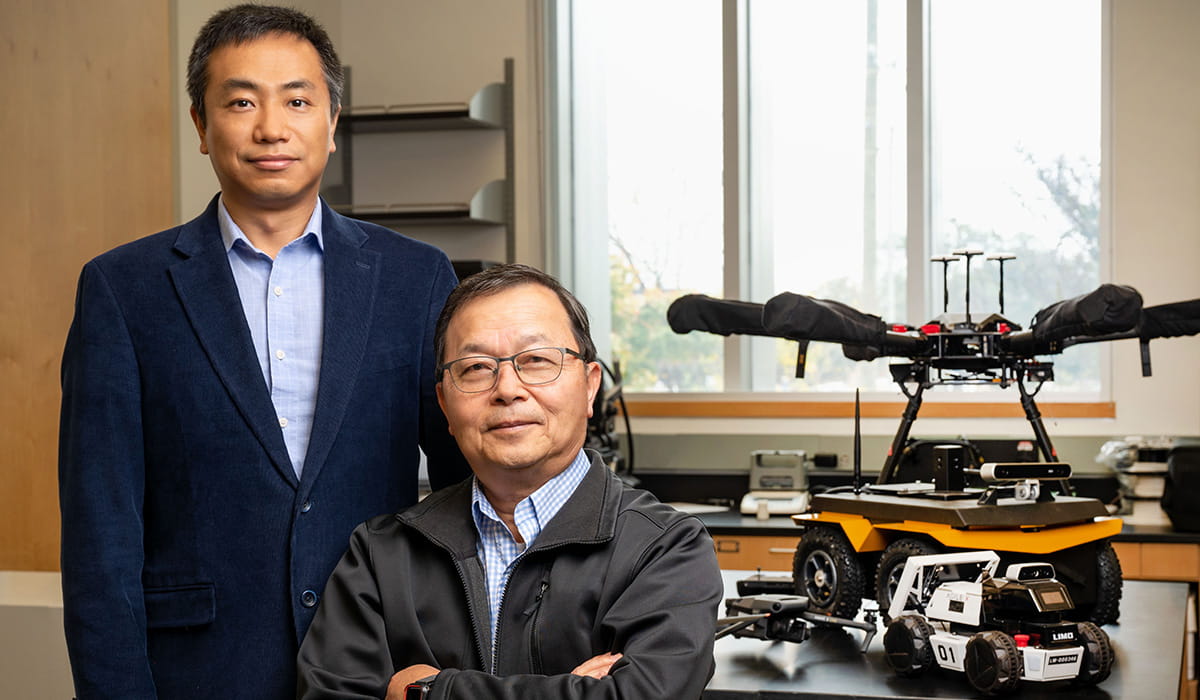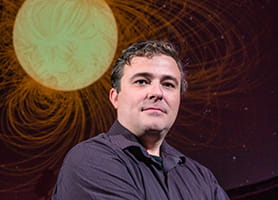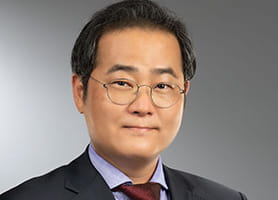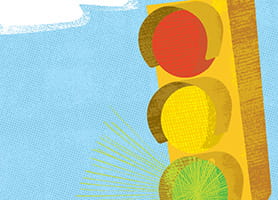Box 19162
Arlington, TX 76019-0162
© 2024 The University of Texas at Arlington
Field Work
From taking a closer look at insect digestion to rethinking the supply chains that bring us our food, researchers at The University of Texas at Arlington are tackling agricultural challenges at every scale.
By Amber Scott
Illustration by Samantha Morales
Deep in the West Texas region known as the South Plains, highways branch into roads that lace through acre upon acre of vast farmland. By late summer, blooming tufts of cotton blanket the land like a thick layer of snow. The South Plains is relatively small, comprising just 24 counties in the area just below the Panhandle, but it is the largest cotton-producing region in the world, with a land area exceeding 3 million acres, depending on the production year.
As they say, everything’s bigger in Texas, and that’s certainly true for its agriculture: The state has more farms than any other in the U.S., over 248,000. Besides cotton—its primary cash crop—the Lone Star State also produces corn, wheat, sorghum, and more. About 74% of the land in Texas is used for agricultural production, resulting in nearly $25 billion for the economy in products sold, according to the most recent Census of Agriculture.
Because of the state’s size, the scale of its farm production, and the overall impact it has on food and commodity resources nationwide, researchers in Texas play a vital role in developing innovative solutions to agricultural challenges that touch every citizen in the United States. Scientists and engineers at The University of Texas at Arlington are doing their part, contributing a growing body of research that will help ensure the continued success and sustainability of the agricultural industry here at home and far afield.
Going With Their Gut
Consider the grasshopper. Thanks to their mandibulate mouthparts, the insects are expert plant devourers, with swarms devastating crops with staggering efficiency. They also thrive in drought conditions—an increasingly common problem in Texas—which provide the voracious critters with more time to feed and reproduce. For example, a single female grasshopper can lay an average of 200 eggs per season, but in ideal conditions—such as a warm, dry autumn—that number can increase to as many as 400.
As one farmer said in The Guardian, “I can only describe grasshoppers in expletives. They are a scourge of the earth.”
While widespread pesticides are commonly used to control grasshopper and other crop pest populations, Alison Ravenscraft, assistant professor of biology, believes there could be a better way. The answer, in fact, may lie deep in the insects themselves.
“Plants defend themselves by producing natural chemicals that are toxic to insects, but insects have many ways to overcome these toxins,” Dr. Ravenscraft says. “The goal of my project is to measure how much help gut bacteria provide to herbivorous insects in breaking down toxic plant defense chemicals.”

While previous research in this area has tended to focus on single insect or bacterial species, Ravenscraft’s work, which is funded by a National Science Foundation (NSF) Early Career Development (CAREER) award, aims to quantify detoxification across the entire gut microbiome in grasshoppers, beetles, and caterpillars. To accomplish this, she and her team of undergraduate and doctoral research students are rearing hundreds of insects from multiple species, infecting them with different bacteria, and then measuring the effects on their health and plant consumption.
“Understanding the different ways insects disable plant toxins will help us design more effective, targeted insect control strategies,” she says. “Ultimately, this could reduce crop losses and lessen the need for broad-spectrum pesticides.”
Ant Invasion
It sounds like a plot straight out of a TV drama about zombies: Much of the southeast United States is in a quarantine zone. Over 270 million acres of land are infested, including most of Texas, with the quarantined area encompassing over 180 counties in the state.
While it reads like fiction, it’s our present-day reality. These quarantine zones are meant to slow the spread of the invasive red fire ant by restricting the movement of hay and nursery-floral commodities to ant-free areas. The invasive red fire ant packs a powerful punch for such a tiny insect, harming not just those unlucky people who stumble across an ant bed, but also the entire agricultural industry. The ants are often found nesting in electrical units and utility housings; in clay-heavy soils, their nests form tall, hardened mounds. In any of these locations, they can cause equipment failure and slow down operations. Ants also feed on sorghum, corn, and small grain seeds and seedlings, which affects crop yield, and they pose a threat to newborn livestock and wildlife.
Farmers have traditionally fought the invasive pest with chemicals and insecticides that aren’t beneficial to the environment, but Shouyi Wang, associate professor of industrial, manufacturing, and systems engineering, and Wei-Jen Lee, professor of electrical engineering, are working on a high-tech, insecticide-free alternative.
“Our motivation is to develop an environmentally friendly solution to the problem of foreign ants,” says Dr. Wang.

“This project is a benefit to farmers, to help them feel less wary about going out into the fields, but it’s also a benefit to humanity.”
With a grant from the U.S. Department of Agriculture (USDA), the researchers are exploring how to use artificial intelligence, the Internet of Things, and unmanned aerial and ground vehicles to deliver green treatment solutions like hot water, water with detergent, or steam directly to a mound—with no physical manpower needed by the farmer. The researchers believe that down the road, their smart system for targeting fire ants could be broadened to include other agricultural applications. For example, a drone that has been programmed to recognize fire ant mounds could be programmed to detect when soil is wet or dry or if certain plants need water more than others.
Dr. Lee notes that as our population increases, the amount of available farmland decreases, so ensuring the sustainability of our agricultural systems is paramount.
“With technology, our goal is always to solve a given problem,” he says. “This project is a benefit to farmers, to help them feel less wary about going out into the fields, but it’s also a benefit to humanity.”
Insect Trackers
Lee has also turned his attention to other pressing agricultural pests. Along with his co-investigator, computer science Professor Gautam Das, he is developing tiny sensors that can attach to insects so their movements and life cycles can more easily be tracked.
“This is a unique approach to the problem of infestations, and we hope to expand our research later,” says Dr. Das. “The use of artificial intelligence in agriculture is a growing field. This is just one small example of how it can make an impact.”
Their project is funded by a USDA grant and includes mathematics Professor and Chair Jianzhong Su and Wendy Shen, a collaborator from the University of Central Florida.
“Insects can positively or negatively affect agricultural quality and production,” Lee says. “Understanding their behavior is an important step to taking advantage of their benefits and mitigating potential damages. Applying advanced sensor technologies and artificial intelligence will have a profound impact on the future development of agriculture.”
From Micro to Macro
Before the COVID-19 pandemic hit, the average person probably didn’t spend much time thinking about food supply chain logistics. But when the pandemic’s interruption of those supply chains began causing empty grocery store shelves and higher prices, they suddenly became a topic of national interest.
For Caroline Krejci, assistant professor of industrial, manufacturing, and systems engineering, it wasn’t a surprise at all.
“It was horrifying, obviously—really scary—but it also confirmed what I and other food systems researchers have been saying for quite a long time,” she says. “It was a confirmation of how fragile centrally controlled food systems are, and how risky it can be to rely on them.”
An expert in logistics, Dr. Krejci is borrowing inspiration from crowdsourced transportation platforms like Uber and Lyft to design a decentralized way for regional farmers to move crops and even livestock through the supply chain. It’s a solution, she says, that would ultimately give consumers and farmers more control over their food.
“When a farmer is selling through a farmer’s market, for example, they’re getting a lot more money than what they’d get if they were selling to a large-scale distributor, and they maintain control over production decisions,” she explains. “You as a buyer have more control because you have more options and you have access to more information, and there’s greater accountability because you can ask the farmer about their production practices and, in some cases, even visit the farm.”
Funded by an NSF CAREER award, Krejci is creating an agent-based model to simulate interactions between farmers and transportation providers, and she’s also talking with farmers to get a sense of what would motivate their decision to use or not use the platform. The grant builds upon funding Krejci received in 2019 to help small- and mid-scale farmers and ranchers in Texas get their products to market through collaborative transportation and aggregation, opening avenues for cost savings and easier delivery.
“With my research, I’m trying to come up with ways to keep the good aspects of a decentralized food supply system—like resilience and sustainability—while also providing the convenience that both producers and consumers value,” she says. “How can we make healthy regional food distribution and access easier for everybody?”
READ MORE

Investigating Earth’s ionosphere-thermosphere
A space physicist at UTA is playing a key role in NASA’s Geospace Dynamics Constellation mission aimed at improving our understanding of the planet’s ionosphere-thermosphere (I-T) system.

Quantifying the benefits of roadside vegetation
Construction management Assistant Professor Kyeong Rok Ryu is helping cultivate a better-looking Texas by creating best practices for roadside vegetation.

Evaluating smart traffic signal design
Civil engineer Pengfei “Taylor” Li hopes to make traffic signals smarter with new simulation techniques and big data.